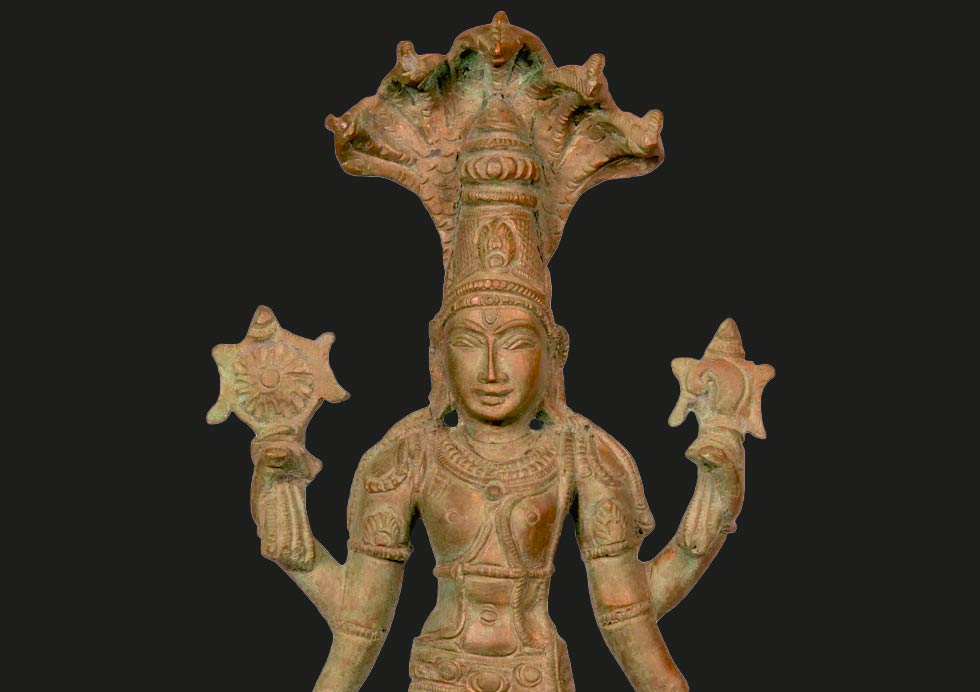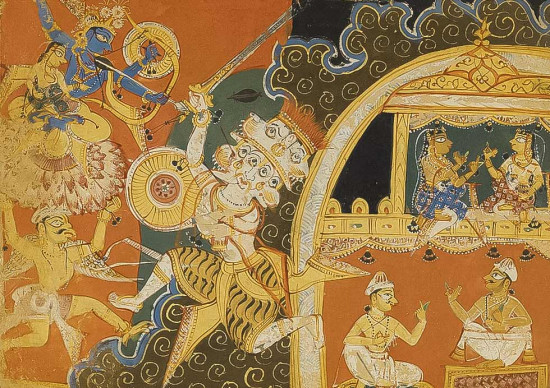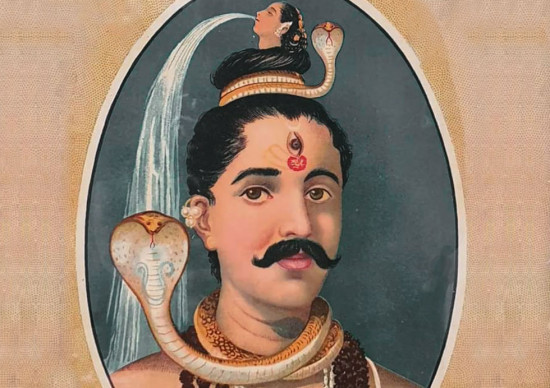
The name “Satyanarayana” is derived from two Sanskrit words—“Satya,” meaning truth, and “Narayana,” referring to the highest being or the supreme deity, Sri Vishnu. This name itself represents Lord Vishnu as the embodiment of truth and the ultimate being who upholds righteousness and order in the cosmos.
Satyanarayana’s divine form teaches the values of selflessness, hospitality, and the power of truth. The central message is that when we live our lives in accordance with the principles of truth and devotion, we will receive the blessings of the divine and be rewarded with prosperity and success.

The Divine Manifestation of Truth and Righteousness
In one of the stories from the Bhaviṣya Purāṇa, Vishnu, in the form of Satyanarayana, teaches the importance of truth to the world. This is also reflected in the story of Śatānanda, a Brahmin from Kāśī, who was instructed to worship Satyanarayana for prosperity and happiness, which later led to his success. Through these divine interventions, Vishnu in his Satyanarayana form underscores the significance of righteousness, truth, and devotion in all aspects of life.
Thus, Vishnu assumes this form primarily during Kali Yuga to help guide people towards spiritual growth through the worship of truth.
Who is Satyanarayana?

The concept of Satyanarayana is rooted in the belief that truth, or "Satya," is the foundation of the universe. By invoking Lord Satyanarayana, devotees connect with the ultimate source of truth, order, and righteousness. The worship of Satyanarayana has been an essential part of Hindu rituals for centuries, and it continues to be a common practice for households seeking prosperity and divine favor.
Satyanarayana’s Symbolism and Divine Significance
Satyanarayana embodies the qualities of truth, love, and righteousness, which are seen as the guiding principles for human life. His blessings are believed to bring prosperity, happiness, and the removal of misfortune. The form of Satyanarayana is also associated with the welfare of individuals, families, and society as a whole, making him a beloved deity for those seeking spiritual and material well-being.
The Significance of the Satyanarayana Puja

The main purpose of the Satyanarayana Puja is to invoke the divine blessings of Lord Vishnu in the form of Satyanarayana, who is believed to be the source of all truth and goodness. During the ritual, devotees offer prayers, light lamps, and read the story of Satyanarayana from the Satyanarayana Katha, which narrates the importance of faith, devotion, and the power of truth in overcoming challenges.
The Satyanarayana Puja is generally performed in a group, and it is considered an auspicious occasion that brings together families, friends, and communities. The devotion expressed during the puja is said to strengthen the bond between individuals and their connection to the divine.
The Story of Satyanarayana
According to the story, once there was a poor Brahmin who was struggling to make ends meet. One day, while performing his daily rituals, he came across a guest who was hungry and tired. In the true spirit of hospitality, the Brahmin invited the guest to his home and offered food and shelter. However, as he was offering his hospitality, the Brahmin became worried about his lack of food and resources.
His guest, who was none other than Lord Vishnu in the form of Satyanarayana, reassured the Brahmin that everything would be taken care of if he maintained his faith and devotion. After the Brahmin performed the puja to Lord Satyanarayana, his life was filled with abundance and happiness, and he never lacked for anything again.
This story teaches the values of selflessness, hospitality, and the power of truth. The central message is that when we live our lives in accordance with the principles of truth and devotion, we will receive the blessings of the divine and be rewarded with prosperity and success.
How to Perform Satyanarayana Puja

The Satyanarayana Puja is simple, yet powerful, and it can be performed at home or in temples. To perform the puja, devotees generally follow these steps:
- Preparation of the altar: Clean the space and set up a small altar. A picture or idol of Lord Satyanarayana is placed on the altar, along with offerings such as fruits, flowers, and sweets.
- Lighting the lamps: The puja begins by lighting oil lamps and incense sticks to create a sacred atmosphere.
- Recitation of the Satyanarayana Katha: The main part of the puja involves reciting the Satyanarayana Katha, which recounts the story of Lord Vishnu’s form as Satyanarayana. Devotees are encouraged to listen to the story with utmost reverence and devotion.
- Offerings: Devotees offer various items such as fruits, coconut, and sweets to Lord Satyanarayana while chanting mantras.
- Aarti: At the conclusion of the puja, an aarti is performed to honor Lord Satyanarayana, and prayers are offered for blessings and prosperity.
- Prayers for health, wealth, and success: Devotees offer prayers for their well-being, career growth, and success in personal and professional life.
Why Worship Satyanarayana?
Worshipping Lord Satyanarayana offers several benefits to devotees. Some of the primary reasons for performing the Satyanarayana Puja include:
- Spiritual growth: The puja helps devotees connect with Lord Vishnu and receive his divine blessings. By following the principles of truth, righteousness, and devotion, devotees strengthen their spiritual journey.
- Prosperity and success: People often turn to Lord Satyanarayana when they seek success in their career, business, and personal life. The puja is believed to bring prosperity, remove financial hardships, and bring stability in life.
- Removal of obstacles: The worship of Satyanarayana is said to remove obstacles and negative energies, leading to a smoother path in life.
- Blessings for new ventures: The puja is commonly performed during the start of new ventures, such as moving into a new house, beginning a new business, or starting a family. Lord Satyanarayana’s blessings are believed to bring success and happiness in these new endeavors.
Conclusion
Lord Satyanarayana’s divine form teaches us the importance of living our lives with truth, honesty, and devotion. It reminds us that through faith and dedication, we can overcome obstacles, achieve success, and lead a fulfilling life in alignment with the cosmic order. So, whether it is for a new beginning, a celebration, or to seek divine blessings, the worship of Lord Satyanarayana remains a powerful means to invoke Lord Vishnu’s grace and experience his eternal blessings.
The story of Lord Vishnu taking the form of Satyanarayana is mentioned in several ancient texts, particularly in the Skanda Purana (Revā Khaṇḍa) and the Bhaviṣya Purāṇa. The Skanda Purāṇa provides the details of the Satyanarayana Vrata Katha, which narrates the origin and significance of worshiping Lord Satyanarayana, especially in Kali Yuga. Additionally, references to the Satyanarayana story can be found in texts like the Pratisargaparvan of the Bhaviṣya Purāṇa, which further elaborates on the benefits of worshiping Satyanarayana for prosperity and well-being.
These accounts emphasize the connection between Lord Vishnu's incarnation as Satyanarayana and the benefits devotees can receive through worship, particularly in times of distress and adversity.









